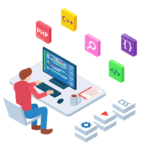Online distance learning can seem like one, big, monolith, but the ways and means of learning online are as varied and intricate as in-person instruction. Not all online learning is the same. The methods of online learning vary with the student, the program, the school they are attending, and the distance involved. There is no such thing as “one” type of online learning program.
Many online e-learning education formats are often tailor-made to suit the needs of distance learners. They take into account the materials needed, the best way to present those materials, and the most optimal method to assess learners’ comprehension of said material, which is why there are three distinct types of distance learning that are popular today.
Video Conferencing
Video conferencing can be broken down into several sub-categories that apply to different learner levels and the program being studied. The traditional view of video conferencing is that of one person communicating with another through a video platform like Skype or Zoom. While that definition holds through most cases – like one-on-one classes or private lessons between tutor and student – there are exceptions to that definition.
These exceptions became manifest during the pandemic when the entire worldwide student population was forced to learn via video conferencing. With larger classes, video conferencing may seem less interactive and more of a chore, as it is reduced to basically watching a video of someone talking.
There are platforms that have emerged that incorporate video conferencing with more interactive elements. In these new platforms, students can ask questions through a chat feature or engage in a discussion with their fellow students or teacher. Teachers have also learned to stop the one-way dynamic and prompt students with questions or discussion items to break up the routine.
Hybrid Distance Education
As the name suggests, hybrid distance education brings disparate elements together to create a more complete form of online learning. The two elements that are combined are:
- Synchronous learning – students attend scheduled classes virtually through video conferencing or live stream, or otherwise learn in real-time
- Asynchronous learning – students do not attend scheduled classes or lectures, but are assigned coursework with the help of online study tools like Studocu that provides comprehensive study materials to complete on their own schedule and submit it by an assigned deadline
These are the two foundations of hybrid distance education. They both retain elements of learning in person (attending classes and lectures, even virtually, at scheduled times), while also bringing in the most valued aspect of online learning: setting your own schedule. Hybrid learning offers the best of both worlds, but it is not for everyone.
Hybrid distance education requires discipline and motivation. Students who practice e-learning online education are usually accustomed to the schedule and demands placed on them to keep on track without any instructor looking over their shoulder to make sure they complete their work or studies.
Open Schedule Online Courses
If you took out the synchronous part of hybrid distance education, you would get open schedule online courses. The name says it all. With OSOC, students are completely free from having to attend scheduled classes or lectures. They are simply assigned coursework at the beginning of the semester – or whatever schedule the instructor puts forth – and are then left to their own devices to complete the work.
There are only set deadlines for when the work must be submitted, but daily, weekly or monthly classes are excluded. Students receive the materials they need whether online or through digital documentation shared with online PDF tools like Lumin PDF. They receive course outlines and instructors offer specific hours where they can meet with students to provide assistance or guidance.
Open schedule courses are also for the most disciplined, self-starting students. Only students with a specific skill set, like time management and organizational skills, should pursue this type of online e-learning education. It requires a lot from the student in return for the freedom to work according to your own schedule.








